Sumitomo Rubber Industries Bundle
How did Sumitomo Rubber Industries rise to global prominence?
Journey back in time to 1909, when the seeds of Sumitomo Rubber Industries SWOT Analysis were first sown with an investment in Dunlop Japan. This pivotal moment launched a remarkable trajectory for a company that would redefine the rubber industry. From its humble beginnings, Sumitomo Rubber Industries, or SRI, has become a global powerhouse, leaving an indelible mark on the world of tires and beyond.
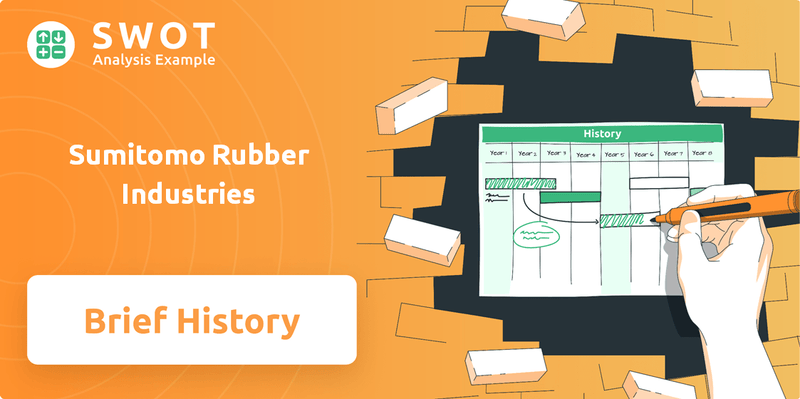
Delving into the SRI history unveils a fascinating narrative of innovation and strategic expansion. From its origins as a Japanese tire manufacturer, Sumitomo Rubber Industries has continually evolved, diversifying its product portfolio and expanding its global footprint. This commitment to growth is further exemplified by its ambitious 'R.I.S.E. 2035' strategy, which aims to propel the company to new heights in the rubber industry, solidifying its position as a leader in the market.
What is the Sumitomo Rubber Industries Founding Story?
The founding of Sumitomo Rubber Industries is rooted in Japan's early rubber industry development. It began with the establishment of Japan's first modern rubber factory in 1909 by Dunlop U.K. in Kobe, Japan. The Sumitomo Group's investment in Dunlop Japan was a pivotal move, setting the stage for Sumitomo Rubber Industries.
The company's inception was driven by the Sumitomo Group's recognition of the growing opportunities in the rubber sector, especially for automotive tires. The initial challenge was to meet the rising demand for rubber products, particularly tires, in Japan's industrializing economy. Dunlop's expertise, combined with the Sumitomo Group's investment, provided the necessary resources.
The original business model centered on manufacturing and selling rubber bicycle tires, tubes, and solid rickshaw tires. The product line quickly expanded to include automobile tires by 1913, producing Japan's first such tire. This early focus on tires was crucial for the company's initial growth and market positioning.
Sumitomo Rubber Industries' history is marked by strategic investments and acquisitions, including the formal incorporation as a Japanese corporation in 1917 with ¥1.18 million capital. The company's evolution reflects Japan's industrial growth and the increasing demand for modern transportation.
- 1909: Dunlop U.K. establishes Japan's first modern rubber factory in Kobe.
- 1913: Production of Japan's first automobile tire.
- 1917: Formal incorporation as a Japanese corporation.
- 1963: Sumitomo Group acquires control of Dunlop Japan and renames it Sumitomo Rubber Industries Ltd.
The close relationship between Sumitomo and Dunlop continued for many years. This relationship culminated in the Sumitomo Group acquiring control of Dunlop Japan in 1963, subsequently renaming it Sumitomo Rubber Industries Ltd. This acquisition was a significant step, solidifying Sumitomo's management and marking a pivotal moment in its independent growth. The cultural and economic context of Japan's industrialization and the growing need for modern transportation played a crucial role in shaping the company's early focus and development. For more insights into the company's business model, consider reading about Revenue Streams & Business Model of Sumitomo Rubber Industries.
Sumitomo Rubber Industries SWOT Analysis
- Complete SWOT Breakdown
- Fully Customizable
- Editable in Excel & Word
- Professional Formatting
- Investor-Ready Format
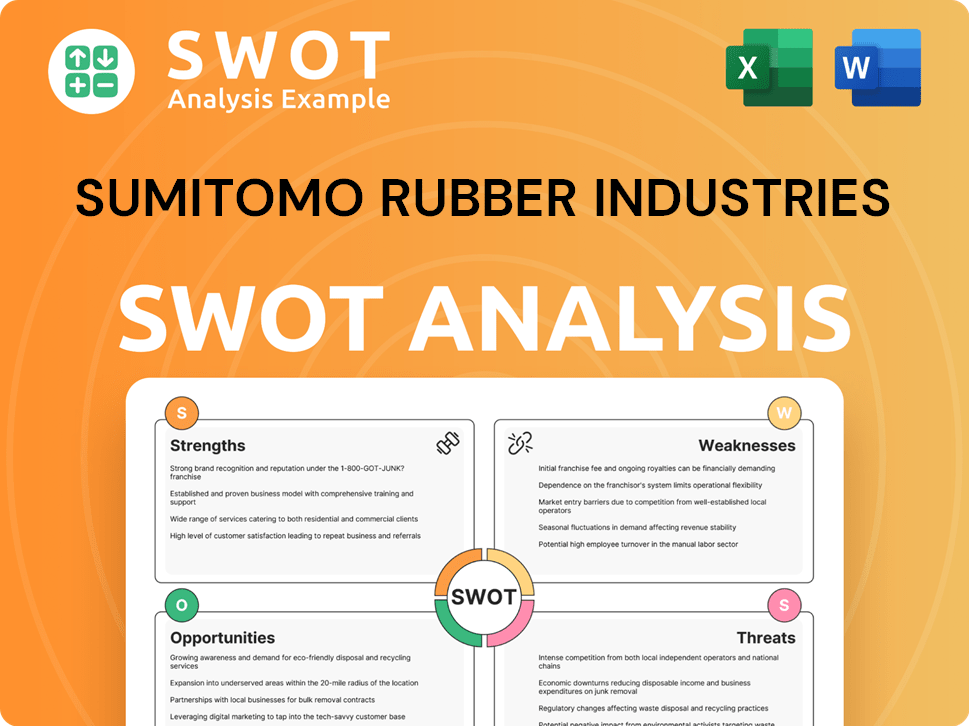
What Drove the Early Growth of Sumitomo Rubber Industries?
The early years of Sumitomo Rubber Industries (SRI) were marked by significant growth and expansion. After producing Japan's first automobile tire, the company quickly diversified its product line. This strategic move allowed SRI to establish itself as a key player in the rubber industry, expanding its reach both geographically and in terms of product offerings.
SRI expanded its product range beyond automobile tires. By 1930, the company was producing golf and tennis balls, and by 1935, it had added motorcycle tires to its offerings. This diversification helped solidify SRI's position in the market and broadened its revenue streams, showcasing its adaptability and forward-thinking approach.
Technological innovation was a cornerstone of SRI's early success. A major breakthrough came in 1954 with the development of Japan's first tubeless tire. This was followed by the mass production of the 'SP3' radial tire in 1966, a significant advancement that set new standards in the Mission, Vision & Core Values of Sumitomo Rubber Industries.
SRI formed a pivotal strategic alliance in 1997 with The Goodyear Tire and Rubber Company, which was dissolved at the end of 2015. In 1984, the company made significant acquisitions, including six tire plants in the UK, Germany, and France, along with the Dunlop Tyre Technical Division in the UK. In 1986, SRI acquired Dunlop Tire Corporation in the U.S.
SRI expanded its manufacturing footprint significantly. The Nagoya Factory began operations in 1961, followed by the Kakogawa Factory in 1972, and the Shirakawa Factory in 1974. Geographical expansion continued with the Malaysia Factory commencing operations in 1981. This growth reflects SRI's commitment to increasing production capacity and reaching new markets.
Sumitomo Rubber Industries PESTLE Analysis
- Covers All 6 PESTLE Categories
- No Research Needed – Save Hours of Work
- Built by Experts, Trusted by Consultants
- Instant Download, Ready to Use
- 100% Editable, Fully Customizable
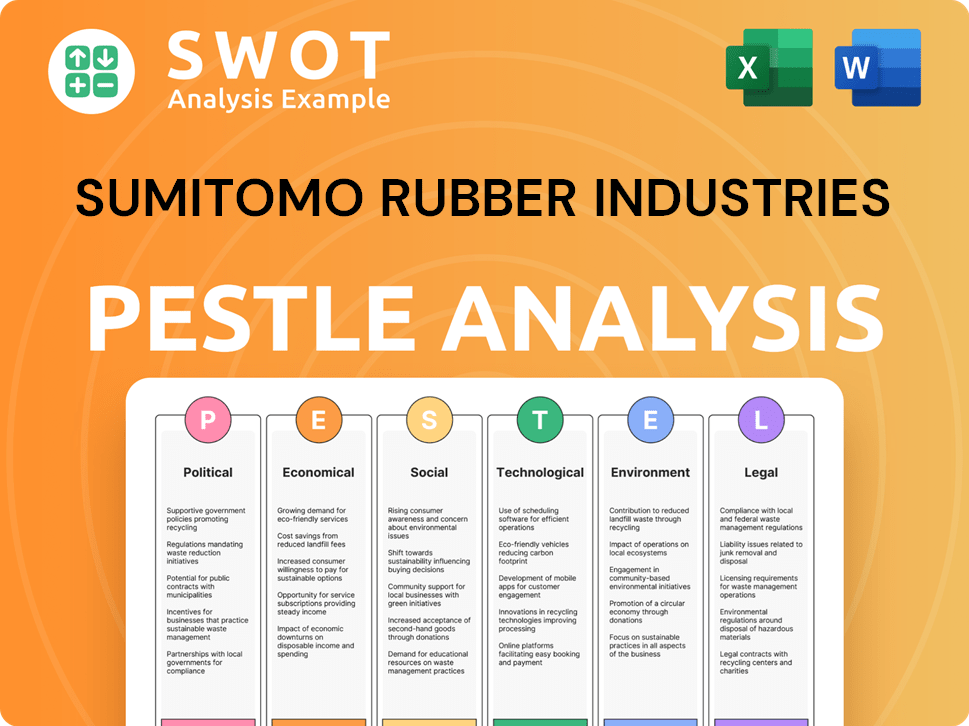
What are the key Milestones in Sumitomo Rubber Industries history?
The SRI history reveals a journey marked by significant milestones, strategic acquisitions, and technological advancements within the rubber industry. From pioneering digital technologies to expanding its brand portfolio, Sumitomo Rubber Industries has consistently adapted to the evolving market dynamics.
| Year | Milestone |
|---|---|
| 1998 | Developed 'Digi-Tyre' using digital rolling simulation technology. |
| 2014 | Released 'ENASAVE NEXT,' a tire with 50% less rolling resistance. |
| April 2017 | Acquired the rights to the global use of Dunlop brand sports goods trademarks. |
| May 2025 | Finalized the acquisition of the Dunlop trademark and other rights for four-wheel tires in Europe, North America, and Oceania from Goodyear for US$526 million. |
Sumitomo Rubber Industries has consistently pushed the boundaries of tire technology. The company's focus on innovation is evident in its development of advanced materials and sustainable practices within the rubber industry.
In 1998, SRI pioneered the use of digital rolling simulation technology, leading to the creation of 'Digi-Tyre'. This innovation marked a significant step in tire design and performance optimization.
The 'ENASAVE NEXT' tire, released in 2014, showcased SRI's commitment to environmental sustainability by reducing rolling resistance by 50%. Subsequent versions, like 'ENASAVE NEXT II' in 2016, incorporated advanced material development technologies.
In 2017, SRI unveiled its 'SMART TYRE CONCEPT,' a new technology development concept aimed at achieving new levels of environmental and safety performance. This concept highlighted SRI's forward-thinking approach to tire technology.
In March 2025, SRI won the 'R&D Breakthrough of the Year' for its 'ACTIVE TREAD Technology'. This technology allows tire rubber to adapt to changes in road surfaces, improving performance.
In January 2025, Sumitomo Rubber and Mitsubishi Chemical launched a collaboration to recycle carbon black for tires. This marks a world-first commercialization of products made from recycled tires using coke ovens.
Despite its successes, Sumitomo Rubber Industries has faced several challenges, including market downturns and operational setbacks. The company's resilience is evident in its strategic responses and continued investment in innovation.
The rubber industry is subject to market fluctuations, which can impact sales and profitability. SRI has had to navigate these challenges through strategic planning and diversification.
The tire market is highly competitive, requiring continuous innovation and efficiency. SRI faces competition from both established and emerging tire manufacturers.
The Great Hanshin-Awaji Earthquake in 1995 caused significant damage to the Kobe Factory, leading to its closure. This event presented operational and financial challenges.
In November 2024, SRI announced the closing of its plant in Tonawanda, N.Y., and the dissolution of its Sumitomo Rubber USA LLC subsidiary. This resulted in significant impairment and restructuring losses.
Sumitomo Rubber Industries Business Model Canvas
- Complete 9-Block Business Model Canvas
- Effortlessly Communicate Your Business Strategy
- Investor-Ready BMC Format
- 100% Editable and Customizable
- Clear and Structured Layout
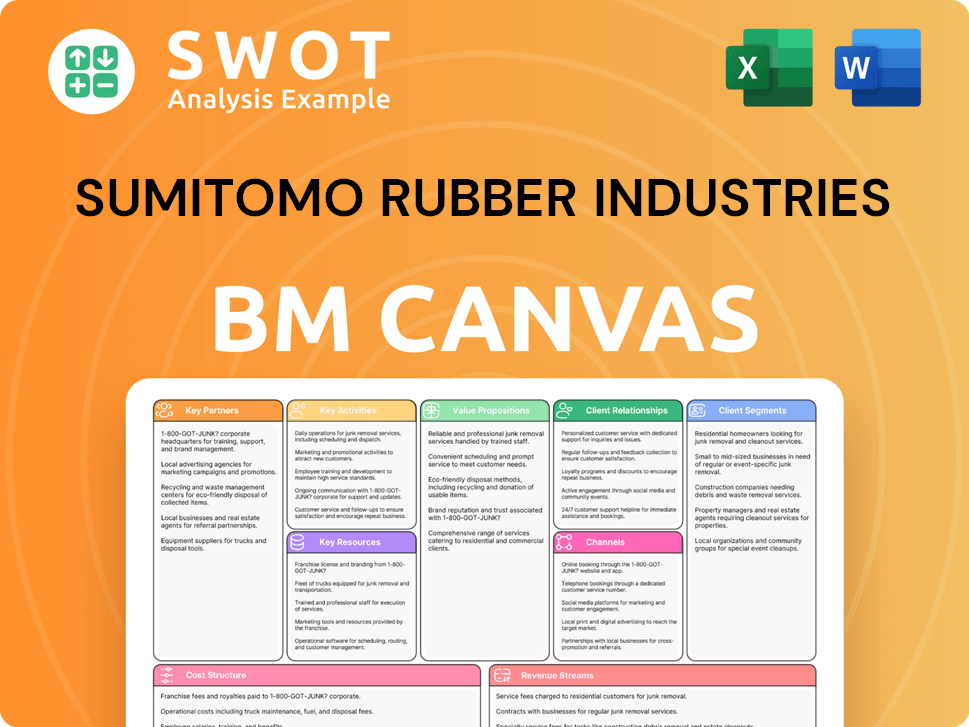
What is the Timeline of Key Events for Sumitomo Rubber Industries?
The history of Sumitomo Rubber Industries (SRI) is a chronicle of innovation and strategic evolution within the rubber industry. From its early beginnings in Japan to its global expansion, the company has consistently adapted to market demands and technological advancements. The acquisition of Dunlop Japan by the Sumitomo Group in 1963 marked a pivotal moment, leading to the company's renaming and setting the stage for its future growth. SRI's commitment to research and development, exemplified by the introduction of the 'SMART TYRE CONCEPT' and the establishment of innovation centers, underscores its dedication to maintaining a competitive edge. The company's story is a testament to its resilience and forward-thinking approach. Learn more about the Target Market of Sumitomo Rubber Industries.
| Year | Key Event |
|---|---|
| 1909 | Dunlop U.K. establishes Japan's first modern rubber factory in Kobe; Sumitomo Group invests in Dunlop Japan. |
| 1913 | Production of Japan's first automobile tire begins. |
| 1917 | Incorporated as a Japanese corporation. |
| 1930 | Starts production of golf and tennis balls. |
| 1954 | Develops Japan's first tubeless tire. |
| 1963 | Sumitomo Group acquires control of Dunlop Japan; company renamed Sumitomo Rubber Industries, Ltd. |
| 1966 | Starts mass production of Japan's first radial tire, 'SP3'. |
| 1984 | Acquires six tire plants in the UK, Germany, and France, and Dunlop Tyre Technical Division in the UK. |
| 1986 | Acquires Dunlop Tire Corporation in the U.S. |
| 1997 | Forms a joint venture in the tire business with The Goodyear Tire and Rubber Company. |
| 2009 | Celebrates its 100th anniversary and completes the Tire Technical Center. |
| 2015 | Dissolves alliance agreement and joint ventures with The Goodyear Tire & Rubber Company. |
| 2017 | Acquires rights to the global use of Dunlop brand sports goods trademarks; introduces 'SMART TYRE CONCEPT.' |
| 2020 | Establishes 'Our Philosophy,' a new corporate philosophy structure. |
| 2023 | Establishes 'TOWANOWA,' a business model for a circular economy in the tire business. |
| 2025 (Jan) | Launches collaboration with Mitsubishi Chemical to recycle carbon black for tires. |
| 2025 (May) | Finalizes acquisition of Dunlop trademark and other rights for four-wheel vehicle segment in Europe, North America, and Oceania from Goodyear. |
SRI has unveiled its 'R.I.S.E. 2035' long-term corporate strategy, aiming to double its operating profit margin to the 15% range by 2035. This strategy focuses on expanding the premium tire segment to 60% of total sales and building new revenue streams in non-tire businesses. The company plans to increase the proportion of premium tires to 60% of total tire sales from the current 40%.
The company aims to achieve a return-on-equity of 12% in the long term, with a mid-term goal of 10% by 2027. SRI is targeting a return-on-invested-capital (ROIC) of 8% by 2027, increasing to 10% for 2030-2035, up from the current 6%. The company's operating profit margin for fiscal 2024 was 7.3%.
SRI will strengthen the Dunlop brand globally and promote global brand management centered on Dunlop. The company plans to establish an 'innovation lab' in North America by 2026 and a 'quantum computer innovation center' in Japan by 2028 to enhance 'rubber-value creation'. The company expects 70% of its earnings to come from tires and 30% from non-tire businesses by 2035.
The company will invest in process R&D, promote cutting-edge technology, and increase collaborations with universities and startups. SRI plans to pursue merger and acquisition activities to support its growth strategy. By 2035, the company expects 70% of its earnings to come from tires and 30% from non-tire businesses, a significant shift from the 87% tire and 13% non-tire ratio in fiscal 2024.
Sumitomo Rubber Industries Porter's Five Forces Analysis
- Covers All 5 Competitive Forces in Detail
- Structured for Consultants, Students, and Founders
- 100% Editable in Microsoft Word & Excel
- Instant Digital Download – Use Immediately
- Compatible with Mac & PC – Fully Unlocked
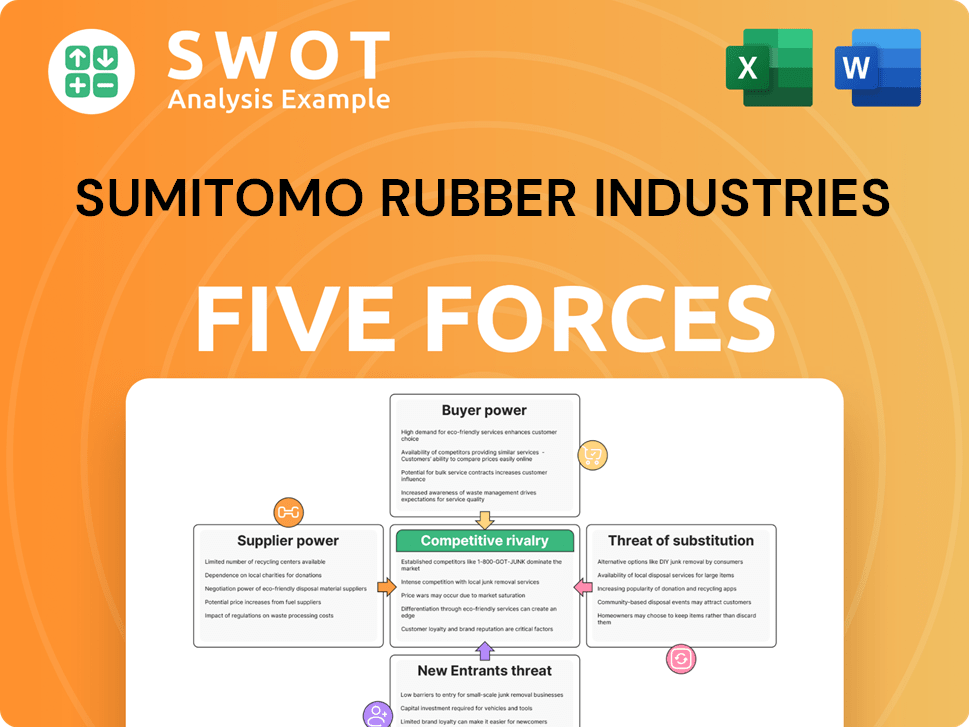
Related Blogs
- What is Competitive Landscape of Sumitomo Rubber Industries Company?
- What is Growth Strategy and Future Prospects of Sumitomo Rubber Industries Company?
- How Does Sumitomo Rubber Industries Company Work?
- What is Sales and Marketing Strategy of Sumitomo Rubber Industries Company?
- What is Brief History of Sumitomo Rubber Industries Company?
- Who Owns Sumitomo Rubber Industries Company?
- What is Customer Demographics and Target Market of Sumitomo Rubber Industries Company?
Disclaimer
All information, articles, and product details provided on this website are for general informational and educational purposes only. We do not claim any ownership over, nor do we intend to infringe upon, any trademarks, copyrights, logos, brand names, or other intellectual property mentioned or depicted on this site. Such intellectual property remains the property of its respective owners, and any references here are made solely for identification or informational purposes, without implying any affiliation, endorsement, or partnership.
We make no representations or warranties, express or implied, regarding the accuracy, completeness, or suitability of any content or products presented. Nothing on this website should be construed as legal, tax, investment, financial, medical, or other professional advice. In addition, no part of this site—including articles or product references—constitutes a solicitation, recommendation, endorsement, advertisement, or offer to buy or sell any securities, franchises, or other financial instruments, particularly in jurisdictions where such activity would be unlawful.
All content is of a general nature and may not address the specific circumstances of any individual or entity. It is not a substitute for professional advice or services. Any actions you take based on the information provided here are strictly at your own risk. You accept full responsibility for any decisions or outcomes arising from your use of this website and agree to release us from any liability in connection with your use of, or reliance upon, the content or products found herein.